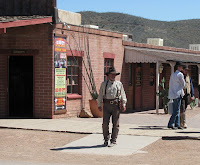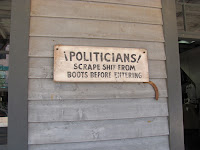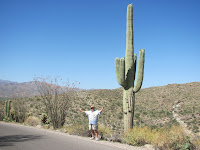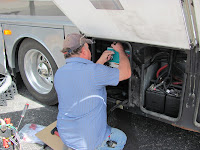Benson, AZ, is located about 40 miles southeast of Tucson, and centrally located to a couple places we wanted to see plus it meant we could visit with our good friend, Mike, who works in Tucson during the week.
We were still having issues with the electrical system and figured it had to be tied to the inverter/converter which converts the DC power (12 volt) into AC power (110) mainly used when drycamping. The fact that this was our 3rd set of batteries in 3 years indicated that something else was wrong, and even after the new set last week, we kept getting an over temperature warning.

We checked in at
Cochise Terrace RV Resort (
http://www.cochiseterrace.com/) and had a spot directly across from the office in their short term asphalt lot. The spaces were large pull-thrus with a nice view of the mountains in the distance, and the staff was extremely friendly and helpful. Their resort map/brochure listed several RV repair places in the area including several mobile units, so Russ made a couple calls the next day, and Alan from
Bondurant Mobile RV Service came out within the hour. He quickly confirmed our suspicions…the fan in the inverter was not working which was causing the drain on the house batteries and the overheating issue. Before he h

ad even arrived, he had charged the gal in his office with locating a new one just in case. She located one in CA, and he was going to try to get authorization for coverage under our extended warranty since this issue with the inverter has been ongoing for some time. That evening Mike came over for dinner, we had a great visit, and made plans to meet up for lunch in Tucson on our way out of town Mon.

Halfway between Benson and Bisbee lies the most famous western town in the world, Tombstone, site of the Gunfight at the O.K. Corral. Also known as “The Town Too Tough to Die”, Tombstone is a living, breathing town that still maintains the atmosphere of the old west especially on Allen Street which is closed off to cars. You can take a narrated stagecoach or covered w

agon tour of the town, cowboys and saloon girls roam the streets, and you can even see a reenactment of the famous gunfight (for a small fee, of course). Tombstone is nothing if not a definite tourist trap, but a fun one. Shoot, you might even see Doc Holliday or Wyatt Earp moseyin’ along.


We ate lunch at the Crystal Palace Saloon (
http://www.crystalpalacesaloon.com/), which has received the Best Historically Accurate Saloon award by True West Magazine. In photos of then and now, the bar itself looks the sam

e except now there are tall chairs for sitting whereas back then you just bellied up to the bar! When we walked in, Russ had hoped that this sexy little saloon gal was going to be our server, but alas we got the cowboy.
After lunch we moseyed over to the Tombstone Epitaph building, where the oldest continuously published paper in Arizona is still being printed. Inside is a small museum of period furnishings, old presses, and walls covered with articles and history all at no charge (wow, there
is a free attract

ion in Tombstone!)
On our way out of town we had to make a stop at Boot Hill Graveyard (another free attraction!) It was given this name because most of its early occupants died with their boots on. Contrary to popular belief, none of the Earp boys are

buried here nor is Johnny Ringo or Ike Clanton, but Billy Clanton and two others who were killed at the OK Corral gunfight are. Some of the tombstones are quite interesting to read. One of our favorites was:
Here lies George Johnson, Hanged by Mistake 1882, He was right, we was wrong, But we strung him up and now he’s gone.
Oh, and on the way back to Benson, we went through another border patrol checkpoint. So that makes 3 in 3 different states for us.

Sun. we drove the other direction to Saguaro National Park (
www.nps.gov/sagu/index.htm), which consists of two separate districts about 30 miles apart, but we only visited Saguaro East. We arrived too late in the day

to do the Jr. Ranger program as theirs takes several hours, but we toured the visitor center and then took the 8-mile scenic drive. We were both a little disappointed because we had envisioned that there would be way more saguaros. There are thousands of them, just spread out. Did you know that saguaros normall

y live for 150-200 years but don’t get their first “arm” until they are about 65-75 years old? In the picture at right you can see the size of these things as Russ is standing between a mature saguaro on his left and an ocotillo on his right. Amidst all the saguaros and ocotillos are prickly pear and cholla cacti, many of which were in full bloom. Who says there’s no beauty in the desert!

Alan called early Mon. morning to let us know that the inverter had not arrived so we extended our stay at Cochise Terrace, and early Tues. morning he called with good news…he had the inverter and he’d be out within the hour! He and his assistant, David, worked quickly to remove the old inverter, install the

new one, and made sure everything was working properly before they left. We can’t say enough about their professionalism and great service. They don’t have a website but can be reached at (520) 378-0549. By the way, it was covered by the extended warranty so only cost us the deductible and the shipping.
One thing you may not know is that Arizona does not change their clocks for daylight savings time. So in the summer they are basically on west coast time, which is fine except that means that the sun comes up at 5:30 in the morning instead of 6:30 and that means the dogs think it’s time to get up and go outside!
We left Wed. morning, and met Mike for lunch at
In-N-Out Burger (
http://www.in-n-out.com/). This chain is only located in CA, AZ, NV, and UT (though they are talking of expansion to other states), and we hadn’t had an
In-N-Out burger since we left CA in 2000! They
only serve burgers, fries, and drinks…the same basic menu since they opened in 1948. Everything is still made fresh to order, and the fries are made from hand cut, fresh, whole potatoes. Employees are extremely friendly and customer service oriented, and we learned from Mike that they’re starting pay is about $11/hour…maybe we should apply! Another thing we learned from Mike is ordering your burgers “animal style”, meaning mustard is fried into the meat patties as they cook and in addition to the lettuce and tomato they also include pickles, grilled onions and extra spread (basically a Thousand Island dressing). We’d never heard this before but is evidently something the “insiders” know…thanks, Mike! You can also order your fries “animal style” meaning they will come with cheese, spread, and grilled onions. Think we’ll skip that one and just get 'em regular.
